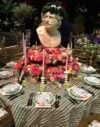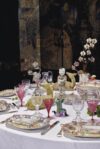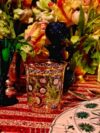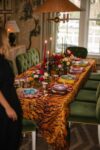
Sustainable Elegance: Towards a More Responsible Art of Table Setting
Redefining what sustainability means
Speaking of sustainable elegance doesn’t necessarily mean simplicity or linen in muted tones. It’s first and foremost about how we compose, choose, and reinvent what already surrounds us.
The art of table setting can be responsible without being restrained. It can shine, surprise, and tell a story — while staying rooted in a philosophy of reuse and meaning. This is the spirit behind Les Tables de Joséphine: creating beauty from what already exists, but seeing it differently.

The beauty of what we already own
Our homes often hide forgotten treasures — a set of dishes passed down through family, a tablecloth once considered out of style, a vase received long ago.
When reimagined with care, these pieces regain their charm. An old curtain can become a tablecloth, a sculpture can turn into a centerpiece, a collection of mismatched glasses becomes a conversation.
True sustainability lies in the ability to see things anew — to blend eras, styles, and textures, and to create harmony from familiarity.


Traveling without buying
Creating a table doesn’t always begin with a purchase. It often begins with observation.
A walk in the garden might reveal a branch, a leaf, or a single flower that adds the perfect finishing touch. A trip abroad might bring back a vintage plate found in a market, a piece of fabric, or a small object that later finds its place among candles and porcelain.
Every element carries a story, a feeling, a trace of where we’ve been. In this way, each table becomes a reflection of memory rather than consumption.


Mixing, transforming, storytelling
At LTDJ, the art of table setting lies in the mix. Vintage meets contemporary, modern lines soften beside aged patinas, an unexpected detail catches the eye and shifts the mood.
It’s not about perfection — it’s about creating a living composition, something spontaneous, layered, and soulful.
To make a table “responsible” is, above all, to give it meaning. It’s choosing personality over perfection, originality over uniformity.


The responsibility of beauty
To be responsible in the world of table art is to be attentive — to what we own, what we choose, and what we pass on.
Every object has a story. Reusing it, transforming it, or staging it is a way of continuing that story.
Sustainable elegance isn’t a rigid aesthetic or an environmental slogan. It’s a way of living beauty with awareness and imagination.
It’s the meeting point between respect and boldness, between heritage and freedom.

Conclusion
A responsible table isn’t rigid or minimalist. It’s inventive, sensitive, and deeply personal.
It’s built from what we have, what we find, what we love. It tells of curiosity, of travels, of moments gathered along the way.
Perhaps that’s the truest form of sustainability — the one born from the heart, the eye, and the hand, rather than from a rulebook.



